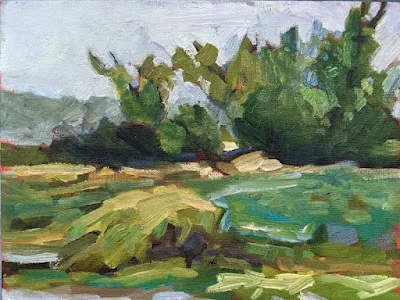Chosen wisely, a painting is a durable asset that will increase in value over time.
 |
| Spring Greens, 8X10, oil on canvas, click for more information. |
If you were in midcoast Maine on Monday, you might have heard my yelp as I cashed out a 16-pound bag of Purina kibble. I checked to see if I’d accidentally scanned it twice. No, it really was $26.48.
I’ve been following the current crisis, of course. I know gasoline is over $5. I’m getting regular pings from Discover telling me, “One of your recurring charges seems different” as they all go up. But sometimes it takes a single purchase to bring home the enormity of the problem, and dog food was it.
 |
| Apple Tree with Swing, 16X20, oil on canvas, click for more information. |
This all seems sadly familiar. Inflation, a GDP contraction, whiffs of a bear market—“it's all a bit 1970s, but without the decent tunes,” wrote the gossip columnist Steerpike.
There are few sure-fire inflation hedges, but the worst thing to have is money in the bank—especially when it’s earning no interest (which is different from the 1970s). Some of us are investing in groceries, but for those who are a little more flush, art is a recognized inflation hedge.
“Art gives its owners the pleasure of looking at it on their wall, and no rate of inflation can take that away. It is both an investment and a form of consumption, and the latter is quite protected against any macroeconomic conditions. When all else fails, spending money is one surefire inflation hedge. Art also happens to be a durable asset, so the expenditure is not entirely wasteful,” wrote Tyler Cohen of Bloomberg.com.
 |
| Bracken Fern, 9X12, oil on canvas, click for more information. |
This of course requires choosing wisely. Original art by known artists of quality are a different kind of art from mass-market prints of dubious quality. (I’m afraid that here is where NFTs, or non-fungible tokens, will reveal their true worth. In the end, they’re just an ownership record of limited edition digital ‘prints’, not significantly different from the giclee prints we were all hawking a few years ago.)
The problem, of course, is that for every winner who picked up a Van Gogh when he was just an unknown crazy guy, there is a loser who bought art that sank into obscurity. How do you tell the difference? The art market is both excruciatingly logical and highly subjective.
 |
| Apple blossom time, 9X12, oil on canvas, click for more information. |
Educate yourself. Identify artists you love and learn more about them. Are they showing and selling in good venues? Do they have a social media presence? Ten years ago, I’d have said that their gallery representation was a good indicator, but the internet has changed that. In the end, it’s not just about the talent of the painter, but about marketing as well. Van Gogh might never have become famous had his brother’s widow, Johanna van Gogh-Bonger, not tirelessly marketed him after his death.
Of course, if making money is your only consideration, you’re still best off taking all your spare pennies and buying an index fund. Nothing beats equities. But let’s be real here—none of us are shoveling every spare dollar into the future, and art will have a better return than other durable assets like a car, a refrigerator, or a washing machine—assuming those are durable in the first place.

